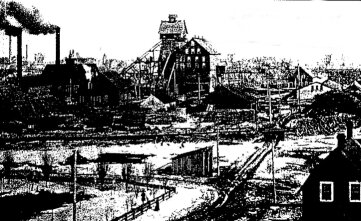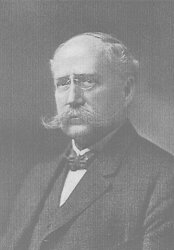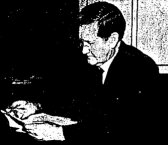The Tamarack Mines Mystery
|
By Donald E. Simanek
English measurement units (feet and inches) are used throughout this document, because those were the units used by the experimenters in 1901 and the units used in all of the source documentation.The essence of the story, as usually told, goes something like this. In the fall of 1901 J.B. Watson, Chief Engineer at the Tamarack copper mine (S. of Calumet, Mich.) suspended 4250 foot long plumb lines down mine shafts. Measurements showed that the plumb lines were farther apart at the bottom than at the top, contrary to expectations. Thus arose one of the long-standing mysteries of science.
Secondary accounts.
|
This incident still appears today in secondary accounts with such incomplete documentation that one is tempted to consider it an urban legend. Certain people with web sites offer it as experimental proof of their conviction that the surface of the earth is concave upwards.
The most frequently seen secondary account is by Ray Palmer (1910-1977), titled "Earth's 'Center of Gravity' — up or down?" appearing in Flying Saucers, Nov, 1960. Palmer, who edited the magazine, had a reputation for embellishing stories based on a minimum of facts.
The incident is also recounted in the 1905 printing of The Cellular Cosmology (The Guiding Star Publishing House, 1898, 1905). This book was written by Cyrus R. Teed and Ulysses G. Morrow, but part II, by Morrow, describes experimental evidences for Teed's Hollow Earth model. The Tamarack mines experiment is mentioned in the 1905 edition of the book (pp. 97-201), but is curiously missing from the 1922 and later editions. Teed was the founder of the Koreshan Unity, a communal religious group. One central tenet of Teed's philosophy held that the earth is a hollow rock shell, and we live and walk on the inside surface of this shell. The entire universe, which is mostly an illusion caused by gravic and levic rays and light, lies within this shell. This complicated view was called the cellular cosmogony, the earth-cell theory or the Koreshan cosmogony. Morrow had, in 1897, carried out an elaborate experiment to measure the surface of water near Naples Florida. This was known as the Koreshan Geodetic Survey. It concluded that the earth was indeed concave upwards. [References: The Naples Geodetic Survey, Morrow's account of the Tamarack experiment, The Houghton Daily Mining Gazette.]
|
The Palmer and Morrow accounts of the Tamarack experiments are alike in many details but differ in important ways. From internal evidence it appears that Morrow's account derives from newspaper accounts, while Palmer's derives from Morrow's and also from newspaper accounts. Palmer's account suggests that an earlier experiment done by the French Geodetic Survey had found strange results when two such plumb lines were side by side in a shaft. The purpose of the French experiments was to measure the radius of the earth. They expected that the plumb lines would converge toward the center of the earth, and by measuring how much closer the plumb lines were at the bottom than at the top, a calculation of the convergence angle could be made. But, to their surprise, they found the plumb lines diverged with depth, being farther apart at the bottom than at the top.
At the Tamarack mines, two such plumb lines were suspended, using No. 24 steel piano wire 4,250 feet long supporting sixty pound steel bobs. The bobs were immersed in vessels of motor oil to damp out vibrations. Just as in the French experiments, these were found to be farther apart at the bottom than at the top. The Daily Mining Gazette described these experiments at length in its Oct. 8, 1901 issue. The Milwaukee Sentinel and other newspapers also picked up the story.
This experiment attracted considerable attention at the time, and even scientists took note of it. They proposed several explanations: drafts in the shaft, magnetic ores influencing the steel wires, and gravitational attraction due to the walls of the shaft. The Milwaukee Sentinel report is quoted in Teed and Morrow:
At another shaft the same phenomena were noticed, and with very little change except that the divergence of the lines was even greater... Several explanations have been offered for the fact that the wires supposed to hang parallel to each other, were farther apart, 4,250 feet below the surface than they were at the surface, but no one has suggested anything that seems to cover the question... With no disturbing forces at work there should be [according to the idea of the earth's convexity] a slight convergence.
|
Professor William Hallock (1857-1913), physicist from Columbia University, read the Mining Gazette article. Hallock had considerable experience with deep mines, as well as deep oil and gas wells, and knew that induced magnetism in steel could be a problem in such experiments. He wrote an article "Magnetic Deflection of Long Steel-Wire Plumb-Lines" that appeared in Electrical World and Engineer 8 Feb 1902 (p. 263, 264) describing experiments he carried out in the Columbia University research shaft, which was at least 75 feet deep. He concluded that gravitational attraction to the shaft walls was too small to cause significant sidewise deflection, but induced magnetism along the length of the steel wires did produce measurable deflections. Therefore he recommended that "Iron or steel wire ought not to be used for plumb lines where accuracy is needed, as they are deflected by the earth's field as well as by each other. Probably phosphor-bronze would prove most suitable where great tensile strength is needed."
Professor Fred W. McNair (1862-1924), physicist and president of the Michigan College of Mines was described as being sufficiently baffled that he, along with other engineers, repeated the experiments in several Tamarack shafts in Feb. 1902. McNair also dismissed "gravitational attraction to the walls" as an inadequate hypothesis, calculating that it could cause a force of no more than a few hundredths of a grain, with no measurable effect on the plumb lines.
|
McNair did address the possibility of magnetic attraction between the steel wires and adjacent iron ventilating pipes. He substituted lead balls and phosphor-bronze wires, which are not magnetic. His results were nearly the same as with steel. He also suspected that air currents might cause sidewise deflection, so he had the shafts closed to prevent that. Still, the 4,250 foot long wires (12 to 17 feet apart at the top) diverged at the bottom by amounts of 0.018 to 0.10 foot.
It must be noted that Hallock's experiments had the two plumb lines separated north/south, a situation where the magnetic effects due to the earth's magnetic field would be greatest. McNair's experiments had the plumb lines separated east/west, where one would expect magnetic field effects to be least.
The Morrow and Palmer accounts then describe a more ambitious experiment, also at the Tamarack mine complex. Two vertical shafts (No. 2 and No. 5) were chosen. They were 3,220 ft. apart. [Palmer says 4,200 feet, Morrow says 3,200 ft.] One plumb line was dropped down each of them. A horizontal shaft at the bottom (4,200 feet deep) connected the two vertical shafts, so the distance between the bobs at the bottom could be measured. It was 8.22 inches greater than at the top. Of course the Koreshans (who were not part of these experiments) proclaimed the experiment confirmed their view of the concavity of the earth.
According to Palmer, these results were never explained by conventional gravitational theory, and he says that McNair and Hallock simply dropped the entire problem. Even today, geologists I've talked to scratch their heads and suspect that the story is a myth.
|
Going back to the sources.
We can check the historic details mentioned by Palmer and Morrow, for names are given in these accounts of the story. In an ongoing effort to check the facts against contemporary accounts, I have now seen a copy of Mc. Nair's paper, Divergence of Long Plumb-Lines at the Tamarack Mine. that appeared in Science, XV, 390 (June 20, 1902), and I've looked at several newspaper accounts of the incident. [I thank Cathy Greer, archivest at the Van Pelt Library of Michigan Technological University for making these materials available to me.]McNair did the experiment in three shafts of the Tamarack mine, shafts 2, 4 and 5. The plumb lines in shaft 5 of the Tamarack mine were 4,250 feet in length. The lines in shaft 2 were 120 feet shorter than in shaft 5. The lines within a single shaft were separated by 15 to 16 feet in several experiments.
After the initial puzzling results in shafts 2 and 5, McNair was granted permission to do further investigations in shaft 4 (this shaft is not mentioned in the Palmer and Morrow accounts). In these experiments 24 B&S gague steel wires were compared with 20 B&S gague bronze wires. Fifty pound lead bobs were used, to meet Prof. Hallock's suggestion that magnetic effects could be a problem. In experiments done from Jan 3-16 of 1902, plumb line convergences as large as 0.028 ft and divergences of 0.141 feet were measured.
 |
| Miners pose with lunch pails outside of the Tamarack mineshaft #5. |
|---|
McNair correctly dismisses the effect of gravitational irregularities of the shafts themselves and density variations of the earth's crust near the shafts, saying
One of the explanations was that the divergence was due to the greater attraction of the material at the end of the shaft for the bob hanging nearest it. It is remarkable how many engineers and other trained persons held to this theory. There seems to exist a general lack of appreciation of the forces of gravitation, except in the single instance of the force between the earth and objects upon it. It is of course true that the attractions of either bob towards the ends of the shafts are different, the stronger being toward the end nearest to which it hangs. Furthermore, these differences of attraction tend to diverge the lines. Their amounts, however, are in this case so insignificant as to put them quite out of consideration in attempting to explain the divergence. Their sum is only a few hundredths of a grain and the consequent divergence only about 0.001 ft.McNair's conclusion agrees very well with my own calculations. Gravitational attraction due to the shaft walls is not the cause of the observed divergences of the plumb lines.
McNair pays special attention to up/down air flow in the shafts. He did experiments comparing the results with reduced air flow and with the plumb lines located differently with respect to air flow from convection currents. He found consistent results to confirm that hypothesis, and even to show the differences between January and September, the currents being stronger in January.
Far from being "baffled", McNair concludes
It seems therefore that a very simple cause was at the bottom of the divergence. The remarkable fact is that the currents of air should be so constant in their action. When, however, the great depth of the shafts is considered, also the constancy for considerable periods of time of the temperatures which may influence these currents, it seems reasonable that this steadiness should exist.
Let's look at the various hypothesized causes of the puzzling results in a bit more detail, to see whether any of them could have been responsible for any part of McNair's results.
Gravitational effects?
We only need a "back of the envelope" calculation here. Gaussian surfaces can be used to advantage. Anything below the bobs exerts a force due to an "inner" spherical distribution of mass, and that's a force downward toward the center of the earth. If the shell of crust above the bobs were fully filled, this, too would give no tangential component of g. But this outer shell of crust has this vertical hole, the mine shaft. A pendulum down this hole exactly centered experiences only downward force; no tangential force. But if the pendulum is off-center, it experiences an attraction to the nearer portion of the wall. This can be calculated by taking a Gaussian cylinder with axis along the pendulum support and the center of the earth. Its radius can be the distance to the farthest wall. Everything outside this Gaussian surface and in the outer crustal shell gives a net force on the bob with no tangential component. Only the portion of the crust in the nearer wall and within the Gaussian surface need be considered. Focusing attention on that tangential component, mass well above the pendulum bob has negligible effect due to the cosine factor and the 1/r2 force law. This will be a small fraction of the downward component of g, of course, but enough to deflect the bob toward the wall.
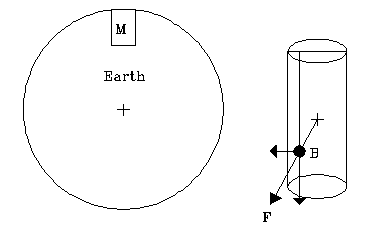
Two bobs in a single shaft cannot both be at the central axis of the shaft, so divergence is expected in any case, from the above analysis. There is, of course, a small direct attraction between two bobs, but it is small compared to the force component toward the walls.
Now here's where it gets interesting. Morrow says that the engineers, puzzled by their results from plumb lines in one shaft, selected two (of many) vertical shafts at that mine site, about 4200 feet apart. These had a horizontal connecting tunnel at the 4200 foot depth (figures approximate). One plumb bob was placed in each tunnel. The horizontal connecting tunnel allowed measurement of the separation of the bobs at that level.
How might they have done that? Surely not by stringing a steel tape measure that far. Tunnels seem too narrow for surveying triangulation to be accurate enough over such a length. Perhaps some engineer can enlighten me on what methods they might have used in 1901. The versions of this story I have seen are silent on this important point.Setting that question aside, would these two pendulums be expected to diverge, even if they were exactly down the center of two vertical shafts? Yes, but the amount is negligible. Could it be from the matter void of the connecting tunnel itself acting as a "nearby" mass anomaly, one of density zero? It's effect can be estimated by calculating the effective repulsion of this void.
This method is often used in mechanics. First calculate the gravitational effect of a simple mass configuration such as a sphere. Then ask what would this be if you had a spherical void of radius r located in the sphere with its center at radius R from the larger sphere's center? So you calculate the solid sphere's gravitational force at whatever specified point, then remove (subtract) the gravitational contribution of a mass equal in volume to that void. Since we do not know the exact size of the shafts, or the exact placement of the plumb bobs relative to the center of the shaft, we don't need any more than a rough calculation.
The results do not support the hypothesis that the observed divergence is due to gravitational effects. The expected sidewise deflection of the plumb line turns out to be only about 0.04 inch for each plumb line, or 0.08 inch greater separation of the two plumb lines at bottom than top. This is only about 1/100 the amount of 8.22 inches reported in the accounts of the two-shaft Tamarack experiments. But remember, we have no contemporary account that this experiment was ever performed in two mine shafts separated horizontally by 3,200 feet. We will return to this point below.
Crustal density variations?
When we read these accounts, we notice that they totally ignore other influences that could move the plumb bobs apart. This was a copper mine, and copper in such mines often comes in huge chunks with a density of about 11 gm/cm3. Chunks the size of a house have been found. The surrounding rock density is about 3.1. A chunk of copper that size near the mine shaft would have a greater effect (almost four times as great) on the plumb bob than a complete void of the same size. We would expect that the sidewise deflections from metal ore deposits could be in any direction, yet the accounts suggest (but do not emphasize) that the only deflection observed was of the bobs moving away from one another. In the single-shaft experiments, this is equivalent to saying that the bobs moved toward the shaft walls.If we wanted to get fussy we could include the bob's attraction to each other in the case where they were in the same shaft. But with a separation of 15 feet or more their attraction to each other is much smaller than their attraction to the walls. And it certainly won't be necessary to consider mutual attraction of the bobs when they are over a mile apart. Since we are calculating the ratio of tangential to radial component of g, we need not know the mass of the bobs. The ratio of the components will give us the deviation angle.
But, as McNair noted, these effects are nowhere near large enough to account for the reported divergences.
Geometry?
The accounts I've seen so far do not mention whether the experimenters corrected for centrifugal effects on the plumb lines. It's a standard homework problem in elementary physics to calculate how much a plumb bob line at the earth's surface will deviate from a true radial line. The plumb line will deflect a bit Southward in the Northern hemisphere. The angle of deflection depends on latitude. For a latitude of 47.3° N (Calumet, Michigan), and a plumb line 4,200 feet long, the angle is 0.003 radian, so the bob is nearly 5 meters South of the radial line passing through its support point. Of course, that line of the plumb bob represents "down", and the mine shaft would have been drilled with reference to such a line, not to the true radial line to the center of the earth.The reason is illustrated in the diagram below:
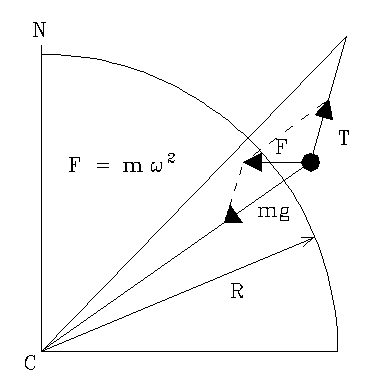
Any body forced to move in a circular path is not in equilibrium, but has a net radial force that maintains its inward acceleration. The size of that force is F = mRw 2 where m is its mass, R is its distance from the center of the Earth and w is its angular acceleration. The pendulum bob moves in a circle around the earth's rotation axis. The net force in the direction of that axis is zero, but the net force in the plane of the circle is F. To achieve that condition, the plumb bob must deflect toward the equator just enough so that the tension force, T and the gravitational force mg add to a centripetal force F of the size and direction to maintain the circular motion.
The equation for the deviation of a plumb line at any particular latitude is:
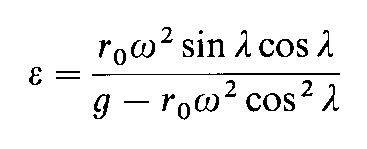
where ε is the deviation in radian, λ is the latitude, ro is the Earth radius, g is the acceleration due to gravity, and ω is the angular velocity of Earth's rotation (radian/second).
This equation shows that the plumb line deviation from the radial line is zero at the poles, and zero at the equator, but it is a maximum at 45° and near maximum at nearby latitudes. Furthermore, the deviation varies only slightly near 45° and therefore plumb lines on a N/S line hang nearly parallel.
But what if the plumb lines were side by side on an E/W line? Various clues in the newspaper accounts, and also in McNair's paper indicate that they were.
Meridians diverge from one another as they go from the North pole to lower latitudes. So the plumb bobs lines not only deflect Southward (about 5 meter) but also deflect outward east/west away from each other. This effect makes them farther apart by only 0.045 cm, compared to their position had there been no centrifugal effects at all. But it's enough to make them nearly parallel.
 |
How the plumb bobs can be parallel. Consider a small portion
of the earth's surface a mile deep. We look straight down on it.
The plumb lines are anchored at the top a distance X apart on
meridians A and D. The points just below its anchors are points E
and F, separated by amount less than X. Being nearly a mile deeper,
they lie on meridians B and C, which are closer together than A
and D. But centrifugal effects cause the bobs to be farther south
along these meridians B and C. It happens that under these conditions
and at mid latitudes, the plumb lines end up very nearly parallel. This figure is schematic and is not to scale. To make the relationships visible, it was necessary to exaggerate the separation of the meridians and the amount of the centrifugal deflection. The mathematical relations all deal with angles so small that the sines of angles approximately equal the angle's radian measure to a very close approximation. |
|---|
|
If this is difficult to visualize, consider the amusement park swing of the type shown here. When it isn't rotating, all swings hang straight down. But when it rotates, the swings move outward, away from the rotation axis. In so doing they also move farther apart—they diverge from each other. The plumb lines on the earth at mid latitudes of the northern hemisphere swing southward, and in so doing they also diverge from the angle they would assume if the earth weren't rotating. Whether this results in a net convergence, divergence, or parallelism of the plumb lines is dependent on the earth's radius, the latitude, and the angular rotation speed of the earth.
Buoyancy?
The experimenters noticed vibrations of the metal wires and measured them. This led them to investigate the air current hypothesis. It also led them to damp the vibrations by suspending the bobs in buckets of motor oil. An interesting fact is mentioned in one newspaper account, in the Daily Mining Gazette of Nov 8, 1901.The bobs were lowered carefully with 8 pound wooden weights on the bottom end, to help guide the lines through wooden supporting structures. Then the 8 pound weights were removed and replaced with 50 pound cast iron bobs. This caused the wire to stretch 15 feet. Then the bobs were immersed in pails of engine oil. According to the Mining Gazette: "Here something un-looked for happened; the wires shortened up 25 inches because of the buoyancy of the oil."
Still, this would have not surprised McNair, even if he hadn't anticipated it. After all, his education was in physics, so he understood buoyancy. But could he have neglected to account for a side-effect of buoyancy? The plumb lines were nearly parallel because they were suspended from such a great height. But, as seen in the reference frame of a rotating earth, the oil in the buckets was subject to a force whose direction was strictly due to gravitational force (downward) and centrifugal force (upward). The buoyant forces were therefore directed upward at a very small angle to the plumb lines, so they had components that acted to move the bobs farther from each other.
Again, calculation shows that this has negligible effect on McNair's measurements.
A misinterpretation?
McNair says, without elaboration, that the "expected" configuration of the plumb lines would be "nearly parallel". He specifically does not say that they should converge toward the center of the earth. When he speaks of "divergence" and "convergence" of the plumb lines, "divergence" means that the lines are farther apart at the bottom than at the top. To McNair, divergence simply means "diverging from parallelism". This strongly suggests that he had carried out the calculation taking centrifugal effects and geometry properly into account.
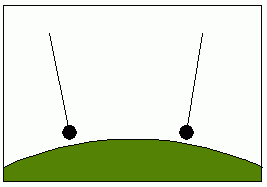
| 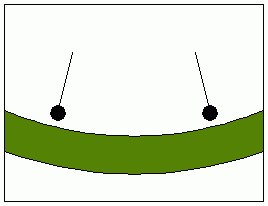 |
| Naive view of plumb lines converging exactly to the center of the earth. |
Plumb lines diverging exactly away from the center of a stationary hollow earth. |
|---|
How much closer would the bobs be to each other at the bottom of a mine shaft at a depth of 4,200 feet, without consideration of centrifugal effects? It works out to 0.21 inches smaller if they were 15 feet apart at the top. This would have been noticed with McNair's measuring methods. This is the convergence that the Koreshans assumed would be observed if the earth where convex, according to conventional geodesy, but without taking centrifugal effects into account.
With centrifugal effects considered, the plumb lines would 1.1 x 10-5 inches farther apart at the bottom than at the top. I.e., the plumb lines would be nearly parallel. McNair couldn't have measured such a small divergence from parallelism. This is what McNair expected: "nearly parallel" plumb lines.
Distances in feet.
Convergence -,
Date, Shaft Wires Bobs Surface Lower Divergence +.
1902 Extrem-
ities.
Jan. 3 No. 4 Bronze. Lead. 15.089 15.061 - 0.028
`` 6 `` 4 Steel. Lead 15.089 15.074 - 0.015
`` 6 `` 4 Steel. Iron. 15.089 15.062 - 0.027
`` 9 `` 4 Bronze. Lead. 14.607 14.611 + 0.004
`` 16 `` 5 Bronze. Lead. 16.709 16.850 + 0.141
|
| McNair's data, from his 1902 Science paper. |
|---|
But McNair did observe deviations from parallelism from -0.004 to +0.141 feet, significantly greater than the result expected from gravity combined with centripetal force. McNair estimated that his measurements had "an error not greater than 0.003 feet". No wonder he was sufficiently interested to take the time and trouble to find the cause. In his short 1902 paper in Science he reports that he was satisfied that the cause was upward and downward air currents in the vertical mine shaft, determined by his careful experiments in which the currents were blocked (as much as possible), and the plumb lines relocated relative to the air flow. During this time McNair was doing quite a different set of experiments in these same mine shafts to measure the vertical variation of the gravitational field strength using precise pendulums at various depths. In his correspondence with John F. Hayford of the U. S. Geodetic Survey there's not a single reference to the plumb line experiments. Clearly these small discrepancies in the plumb line experiments were not a source of great concern to McNair. He indicates that his reason for writing the 1902 paper was the fact that the Houghton Daily Mining Gazette report of observed divergence of the plumb lines had "attracted wide attention and brought forth many attempts to explain its existence". Apparently McNair wanted to set the record straight and give the facts of the matter to counter press exaggerations and speculations. [The Oct 8, 1901 report in the Daily Mining Gazette mentioned a 0.7 foot divergence for plumb lines 15 feet apart but no cases of convergence. McNair's subsequent careful measurements showed both convergence and divergence, no greater than +0.141 feet.]
Morrow had surely read the newspaper accounts. We can't be certain he had read McNair's 1902 paper, but he does say "...in the final experiment of the series, a divergence of .018 of a foot, .216 of an inch" was observed. This does agree exactly with McNair's mention of an experiment (not in the above table) in which the special ventilation "problems" of shaft No. 5 were addressed by hanging the wires in a different location and blocking as much air flow as possible. McNair saw this as confirmation of the hypothesis that deviations from parallelism were caused by air flow. Morrow quotes only this value, which most closely agrees with Koreshan geodesy, "nearer the calculated divergence of gravic rays in a hollow globe". Furthermore, Morrow notes correctly that "this divergence was considerably less...than that obtained when the air in the shaft was in circulation." Morrow seems to be selecting a number that supports his earth model, ignoring the others.
This last McNair experiment, chosen by Morrow to suit his purposes, actually supports McNair's hypothesis of air current effects, but Morrow misreads McNair. McNair had not completely blocked air currents in this final experiment. McNair says "...it was not possible to stop all circulation. There remained a considerable convection circulation whose down-cast portion was concentrated along the casing..."
In case you haven't done the calculation already while reading this, the force required to deflect a 50 lb bob sidewise just one inch, when it hangs from a 4,200 foot wire, is only 0.016 ounce. [Calculation, using a force triangle: (1/12)(50/4200)*16 = 0.016)] That's about the weight of a Ruby-Throated Hummingbird.
So it seems there's no mystery in this whole affair, and no real challenge to conventional geodesy and gravity theory. The Koreshans were citing misleading newspaper accounts and selecting data to suit their philosophical agenda, without understanding the methodology of the experiments or recognizing the centripetal effect due to earth's rotation (which they didn't accept anyway).
Later writers, Palmer for example, built upon this story with careless disregard for accuracy of historical facts, and present-day believers in the inverse geodesy cite Palmer and Morrow, but nothing else.
The two-mine shaft experiment—a myth?
|
At the present time I have been unable to locate any solid evidence that the proposed experiment using two mine shafts 3,200 feet apart was ever performed. Morrow proposed such an experiment in 1897 (in The Flaming Sword, July 1987), and predicted a divergence of 8.22 inches would be found. He even suggested using mine shafts at Calumet, Michigan, or at Pittsburgh, Pa., probably because those were the deepest mine shafts in the World at that time. While he again mentions his earlier prediction in The Cellular Cosmogony edition of 1905, he does not say that the experiment had been performed. Nor does Morrow even mention any plumb line experiments in his 1936 pamphlet Field Theory Publicity. Palmer (1960) related this experiment as if it actually had been carried out, and he repeats Morrow's 8.22 inch value prediction as if it had been experimentally confirmed. But Palmer incorrectly quotes the separation of Tamarack mine shafts 2 and 5 as 4,250 feet apart (mistaking their depth for their separation). McNair's 1902 paper does not mention such an experiment, even as a proposed experiment. So far I have found no evidence that such an experiment was ever done. If any reader can find solid evidence of such an experiment being performed, I'd be happy to hear of it, but until then I must assume it's a myth.
A few more loose ends.
Palmer is the only source I've found of two other stories.Palmer claims that the whole Tamarack affair was inspired by the French Geodetic Survey:
Sometime prior to 1901, the French Government, wishing to determine more accurately the actual size of the Earth, so that they could revise and refine their calculations regarding the distance to the sun, hit on a way to measure the difference in distance apart at the top of two lines perpendicular to the surface of the Earth and the bottom of those same two lines. They wanted a pair of lines long enough to give them an appreciable measurement . Obviously they could not erect two parallel poles a mile high, but they did feel they could suspend two plumb bobs a mile deep into a mine shaft, and thus be able to measure the distance apart at the top and the distance apart at the bottom, which would be slightly less. They wanted to know exactly how much less. The result of these tests was very strange. So strange that the French Geodetic scientists contacted the scientists of the American Geodetic Survey and conveyed their results to them, with the request that similar tests be conducted in this country. Officially, nothing was done for some years. But in 1901, one of the Geodetic surveyors happened to be working in the vicinity of the Tamarack mines near Calumet, Michigan. He contacted the chief engineer at Tamarack, and informed him of the information transmitted by the French government.
If this is a true account, it's strange that McNair never mentions this as a motivation for the experiment. The account in the Oct 8, 1901 Daily Mining Gazette gives a more plausible motivation:
From the new No. 6 shaft, the deepest perpendicular shaft in the world, it was desired to crosscut a distance of 800 feet at the twenty-ninth level, or 4,250 feet from the surface, over to the lode. Already from the twenty-ninth level of No. 2 shaft, which is 3,220 feet at the surface from No. 5... the engineers desired to solve the old tunneling problem—that of beginning work at either end and meeting somewhere near the center.So the Tamarack plumb lines were simply a standard method for establishing the correct direction to dig a horizontal tunnel, by transferring a direction line from the surface down to the bottom of the two plumb lines. This would be done in each of two shafts, and was a method "known to all mining men". It's entirely possible that the French did some similar or related experiment, which Palmer read about, and fitted into his story to lend it believability.In order to do this it was necessary to give the men working from the No. 2 shaft drift the proper direction. Already they had at the mine office a survey from which it would have been possible to have begun work, but it was desired to verify it. It was made years ago, and the engineers thought that the opportunity of satisfying themselves as to its accuracy was at hand. The dropping of the plumb line was the first step.
Chief Engineer J. B. Watson and his assistants went to work to use the method that had been tried many times. It had been tried at the Tamarack mine before and had been a complete success. At the vertical shaft of the Calumet & Hecla, known as the Whiting or Red Jacket shaft, plumb lines had been dropped by the engineers, and at other mines where vertical shafts are in use it had been successfully tried. In principle it was nothing new, but it was practically new, as never before had it been necessary to deal with a shaft close to 5,000 feet deep.
The idea was to drop two plumb lines down the shaft to the twenty- ninth level, then to take observations both at the surface and down in the mine, taking the same data. After this had been done at the new shaft it would be necessary to repeat the operations again at the old shaft, when it would be possible for the engineers to give the miners, working away from the old shaft and toward the new one, the proper directions to enable them to meet the men working in the opposite direction. The idea was a simple one and one that is known to all mining men.
Palmer also claims that after the Tamarack experiments
The United States Geodetic Survey crew for two years conducted further experiments, among them measuring the surface of a long lake in Florida on the theory that water conforms to the true curvature of the Earth's surface regardless of how the land may be, thus giving a true level only to find that the water curved uphill in each direction rather than downhill.Here we wonder if Palmer was misreading the Naples geodetic survey carried out in Florida, not by the U. S. Geodetic Survey, but by Ulysses G. Morrow of the Koreshan Unity, an experiment that I have shown to have been faulty.
There's ample evidence that Palmer is an unreliable source in these matters, for he loved to embellish and skew facts to make a good story. A search of the Internet for "Tamarack Mines Plumb Lines" reveals that Palmer's account is widely quoted (often without attribution) and widely believed to be completely factual.
A final observation.
The promoters of the Koreshan cosmogony assume that the earth is fixed and stationary. They assume as an axiom that the earth does not move or rotate. So they would not have done the above analysis of the plumb line deflection southward and the resulting east/west divergence of two plumb lines. These divergences are in fact solid evidence that the earth does rotate on its axis.
References:
- Palmer, Ray. "Earth's 'Center of Gravity' — up or down?"
appearing in Flying Saucers, Nov, 1960.
- Simanek, Donald. The Naples Geodetic Survey.
- Morrow, Ulysses G. Morrow's account of the Tamarack experiment.
From: Teed, Cyrus. The Cellular Cosmogony. The Guiding Star Publishing House,
1905.
- Morrow, Ulysses G. Field Theory Publicity—The Earth-Cell Concept.
Reprint of Feature Page from New Orleans Sunday Item-Tribune, Jan 5, 1936.
An account of the press interview given by Dr. Morrow. The newspaper title was
"Cult Believes Entire Universe is Housed in Hollow Sphere."
Morrow-McManis Publishing Co., 1936. This pamphlet
also includes "The interview vividly described by Dr. Morrow",
consisting of Morrow's comments related to the interview.
- Plumbing of the Tamarack Shafts
The Houghton Daily Mining Gazette, October 8, 1901.
- Scientific Experiment to Ascertain Earth's Density, Sunday Mining Gazette
(Portage Lake Mining Gazette), Sept 21, 1902. p. 1.
- Hallock, Wm.
Magnetic Deflection of Long Steel-Wire Plumb-Lines.
Electrical World and Engineer. 8 Feb 1902
(p. 263, 264).
- McNair, Fred W.
Divergence of Long Plumb-Lines
at the Tamarack Mine.
Science, XV, No. 390, June 20, 1902, p. 994-996.
- Schadewald and Simanek. Timeline of U. G. Morrow, showing his
evolution from a flat earther to a hollow earther.
![]() This document, ©2003 by Donald E. Simanek. Comments are welcome.
Use the address to the right.
When responding, please indicate the specific document title or URL.
This document, ©2003 by Donald E. Simanek. Comments are welcome.
Use the address to the right.
When responding, please indicate the specific document title or URL.
Return to Myths and Mysteries of Science.
Return to Donald Simanek's front page.
